Drivers
Cotton Owens Garage Racing Drivers
Drivers for Cotton Owens include:
David Pearson,
Buddy Baker,
Pete Hamilton,
Charlie Glotzbach,
Marty Robbins,
Ralph Earnhardt,
Ray Hendrick,
Bobby Isaac,
Junior Johnson,
Marvin Panch and
Fireball Roberts.
Other notables to drive for Owens include
Mario Andretti,
Darel Dieringer,
Al Unser, Bobby Johns, Benny Parsons and Bob Welborn. In all, a total of 25 drivers climbed behind the wheel of Owens' cars in 291 races, earning 32 victories and 29 pole positions. Perhaps you have heard of a few of these guys?
 David Pearson
Born: December 22, 1934
David Pearson
Born: December 22, 1934
Died: November 12, 2018
Hometown: Spartanburg, SC
Driver for Cotton Owens Garage: 1962-1967
Performance in COG cars:
Races: 170
Wins: 27
Top 5: 81
Top 10: 113
Poles: 22
Winner 1966 NASCAR Grand National Championship
View Pearson's Driver Profile page
Read the interview with David Pearson and what it was like driving for Cotton Owens
Read the story of how Cotton Owens gave Pearson a driving lesson at Richmond International Raceway in 1964
View David Pearson's career NASCAR driving statistics
Read David Pearson's introduction on the 1964 Cotton Owens Garage brochure
Read the 1964 Car and Driver article "A Tough Tour with Cotton's Stock Cars" by Brock Yates

David Pearson, a three-time NASCAR Cup champion, is second on NASCAR Cup's all-time win list with 105, second only to Richard Petty.
A fellow Spartanburg, SC, native, his friendship with local car builder Cotton Owens resulted in 15 wins and his first of three NASCAR Championships in 1966 driving his famous white and red #6 COG Dodge Charger.
Pearson was named #1 on NASCAR's 50 Greatest Drivers list and ranks second on NASCAR's all-time pole positions earned with 113, fourth in laps led with 25,425 and sixth overall in races led with 329 races.
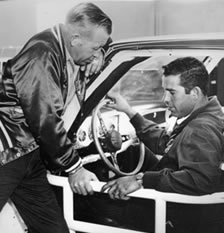 WHAT WAS IT LIKE DRIVING FOR OWENS?
WHAT WAS IT LIKE DRIVING FOR OWENS?
Pearson: "He was good. During the week I’d go over there and help work on the cars too. When they were building new ones, I did a lot of welding on the things. We got along well, we really did. I enjoyed working with him and driving for him. He never did do like some of the drivers say the owners do and try to tell ‘em how to drive and all that. He never said a word to me about what to do or how to drive. I drove it just the way I thought I could drive it and he was satisfied with it. Like I say, we got along good. At motels at night, we would wrestle. We’d do all kind of stuff. He wasn’t like a boss man or nothing like that. He was just like a friend and we enjoyed doing what we were doing together."
For his efforts, he has been inducted into the National Motor Sports Press Association's Hall of Fame at Darlington (SC) Raceway in 1991. Two years later, in 1993, Pearson was inducted in the International Motorsports Hall of Fame in Talladega, Alabama. Then in 1995, Pearson was inducted into Charlotte (NC) Motor Speedway's Court of Legends and in 1998, Pearson was also inducted in the Bristol (TN) Motor Speedway's Heroes of Bristol. In 2010, Pearson was named to the 2011 class in the NASCAR Hall of Fame. He received the most votes, from 50 of 53 voters. "I am just proud that that many people thought enough to vote for me," Pearson said.
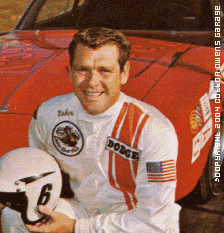 Buddy Baker
Born: January 25, 1941
Buddy Baker
Born: January 25, 1941
Died: August 8, 2015
Hometown: Florence, SC
Driver for Cotton Owens Garage: 1968-1970
Performance in COG cars:
Races: 34
Wins: 1
Top 5: 14
Top 10: 18
Poles: 1
View Baker's Driver Profile page
Watch the video and read the actual press release on Buddy's record-breaking 200.447 mph run
Read the story on Baker's fiery crash at the 1970 Alabama 500 at Talladega Superspeedway
View Buddy Baker's career NASCAR driving statistics
Baker, Dodge Celebrate Record That Won't Be Broken
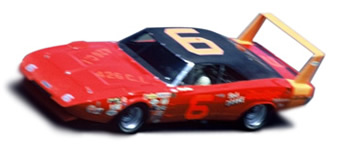 Do you know what it's like to average more than 200 miles per hour in a stock car?
Do you know what it's like to average more than 200 miles per hour in a stock car? Buddy Baker says it's "the greatest" thing in the world. However, the G-forces play havoc with the driver. The new world's record holder said: "Down the straight it's like the force wants to pull you into the back seat of the car and when you get into a corner, you get pushed down in the seat and the belts are so loose they're flapping around on your shoulders." Baker took the world's closed course record at 200.447 in a test run at Talladega, then he practiced some with the windows down - the new ruling from NASCAR prohibits stock cars running with side window glass. Buddy ran 197.5 with the windows down. Do you know what that's like? According to the young Dodge charger, "It's like riding a bicycle behind a tractor trailer...there's a lot of wind."
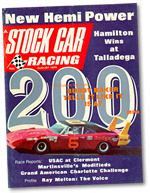
In 1969, Baker and veteran mechanic and car owner Ray Fox were disagreeing privately. Owens selected the rugged, go-or-blow Baker as his pilot and together they competed in 34 races and went on to make history. After Baker's record-setting run on March 24, 1970,
Baker went on to become the first driver to turn a 200-mph lap in a NASCAR sanctioned event when he piloted his Cotton Owens Dodge Daytona around Alabama International Motor Speedway (Talladega) on April 12, 1970.
In September, 1970, Baker would give Cotton Owens perhaps his most prestigious and sought-after race victory, when he won the Southern 500 at Darlington, SC, a race Cotton had entered for 20 years and never won. On the Saturday night before the annual Labor Day classic,
Owens was inducted into the Hall of Fame by the National Motorsports Press Association.
In 1997, Buddy Baker joined his father as an inductee in the International Motorsports Hall of Fame in Talladega, Alabama. He was inducted into the Charlotte Motor Speedway Court of Legends in 1995, and into the National Motorsports Press Association Hall of Fame inductee in 1997. He was named one of NASCAR's 50 Greatest Drivers in 1998.
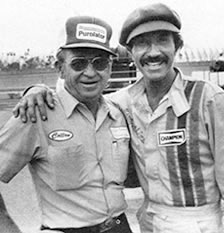 Marty Robbins
Born: September 26, 1925
Marty Robbins
Born: September 26, 1925
Died: December 8, 1982
Hometown: Phoenix, AZ
Driver for Cotton Owens Garage: 1970-1982
Performance in COG cars:
Races: 33
Wins: 0
Top 5: 1
Top 10: 6
Poles: 0
View Marty's Driver Profile page
View Marty Robbins' career discography
View Marty's career NASCAR driving statistics

Marty loved NASCAR racing and as he had the funds to do so, he raced occasionally. His cars were built and maintained by Cotton Owens. Marty Robbins always tried to run at the big race tracks (Talladega Superspeedway, Daytona International Speedway) every year, and then a smattering of the smaller races when time permitted.
In 1983, one year after Robbins' death, NASCAR named the Nashville Fair Grounds race the Marty Robbins 420 in honor of him. Robbins typically ran cars bearing either number 42 or number 22.
Over the years, he ran a few makes and models (Dodges or Fords) before buying a 1972 bodied Dodge Charger race car from Owens. Robbins had 6 top-ten finishes as well as a few major wrecks during the '70s and had Owens rebuild the car and update the sheet metal to the '73-'74 Charger spec, and then finally 1978 Dodge Magnum sheet metal, which he raced till the end of 1980. This car was superbly restored by Owens and donated to the Talledega Museum by his family, and was displayed there from 1983 to 2008. The car is now in private hands in Southern California and raced on the Vintage NASCAR club circuit.
Marty is credited with possibly saving Richard Childress's life at the 1974 Charlotte 500 by deliberately crashing into a wall rather than t-bone Childress's car that was stopped across the track. Marty's final NASCAR race car was a 1981 Buick Regal that he rented and drove in a few races in 1981 and 1982.
 Billy Wade
Born: February 28, 1930
Billy Wade
Born: February 28, 1930
Died: January 5, 1965
Hometown: Houston, TX
Driver for Cotton Owens Garage: 1963-1964
Performance in COG cars:
Races: 32
Wins: 0
Top 5: 5
Top 10: 16
Poles: 0
View Billy Wade's Driver Profile page
View Billy Wade's career NASCAR driving statistics
Read Billy Wade's introduction on the 1964 Cotton Owens Garage brochure
 Billy Wade was the 1963 NASCAR Rookie of the Year for car owner Cotton Owens. He finished the season with 14 Top 10 finishes in 31 races.
Billy Wade was the 1963 NASCAR Rookie of the Year for car owner Cotton Owens. He finished the season with 14 Top 10 finishes in 31 races.
He won four consecutive races the following year for Bud Moore Engineering between July 10 and July 19, 1964. The four wins gives Wade the sole distinction of being the only driver to accomplish this feat with his victories at Old Bridge Stadium 10th, a road course at Bridgehampton, N.Y on the 12th, a July 15 win at Islip Speedway in New York, and fourth win at Watkins Glen. Dick Linder also followed his first victory at Dayton with a win Hamburg; but Wade is the only driver to string four victories in a row once he got his first. He also accumulated five poles and 25 Top 10 finishes in his 35 starts.
Driving for fellow Spartanburg car owner, Bud Moore Engineering, he died during a tire test at Daytona International Speedway in 1965 when his car, which had blown a tire approaching the west turn,
crashed into the wall.
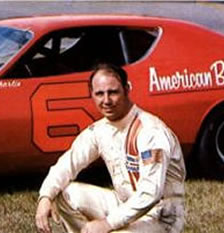 "Chargin'" Charlie Glotzbach
Born: June 19, 1938
"Chargin'" Charlie Glotzbach
Born: June 19, 1938
Hometown: Edwardsville, IN
Driver for Cotton Owens Garage: 1968-1972
Performance in COG cars:
Races: 28
Wins: 1
Top 5: 14
Top 10: 16
Poles: 3
View Glotzbach's Driver Profile page
View Charlie Glotzbach's career NASCAR driving statistics
Watch Chargin' Charlie go for a spin!

"He was a charger," said three-time Indianapolis 500 winner Johnny Rutherford. "That's how he got his name," said four-time Indy 500 winner A.J. Foyt. "He stood on the gas."
Glotzbach drove in 124 NASCAR races and, remarkably, finished in the top 10 in 50 of them. His record includes 12 pole positions and four victories. Eight times he placed second, and he also had five thirds, 18 fourths and three fifths.
His first NASCAR Winston Cup race was in 1960. While never running a full Winston Cup schedule, he ran a partial schedule every year from 1967 to 1975. The most he ran in a single year was in 1968, when he raced in 22 of 48 events. In 1969 he finished second in the Daytona 500 after being passed on the last lap by LeeRoy Yarbrough.
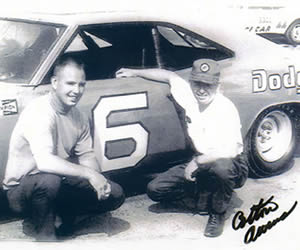 Glotzbach piloted his Cotton Owens Dodge to victory at the 1968 National 500 at Charlotte. They also lost the Daytona 500 of 1969 by a mere .01 of a second to Ford-Mercury king LeeRoy Yarborough. After the Atlanta 500-miler in March, 1969, Glotzbach became fed up with NASCAR rules and quit, which opened the door for Buddy Baker to join up with Owens.
Glotzbach piloted his Cotton Owens Dodge to victory at the 1968 National 500 at Charlotte. They also lost the Daytona 500 of 1969 by a mere .01 of a second to Ford-Mercury king LeeRoy Yarborough. After the Atlanta 500-miler in March, 1969, Glotzbach became fed up with NASCAR rules and quit, which opened the door for Buddy Baker to join up with Owens.
In late 1969, Glotzbach received broken ribs and was shot twice during an altercation with a former employee of his race team, Nichols Engineering. He returned the next season and continued to run competitively with one of the bullets still in his shoulder. (ABC Wide World of Sports Broadcast, 1970 Daytona 500.)
Glotzbach set a World Record of 199.466 mph in September 1969 at Talladega, driving the Chrysler Engineering #88 Dodge Charger Daytona. The car was the pole winner, but Glotzbach, along with most other drivers, sat out the race due to a tire boycott.
His last NASCAR Winston Cup race was in 1992, a season when he competed in seven events. He has four wins and 12 poles in NASCAR.
 Pete Hamilton
Born: July 20, 1942
Pete Hamilton
Born: July 20, 1942
Hometown: Newtown, MA
Driver for Cotton Owens Garage: 1971
Performance in COG cars:
Races: 20
Wins: 1
Top 5: 11
Top 10: 12
Poles: 2
View Hamilton's Driver Profile page
View Pete Hamilton's career NASCAR driving statistics

Pete Hamilton made 64 NASCAR Grand National starts with impressive results. He scored 33 Top Ten finishes, 26 Top Fives, and 4 Wins along with 3 Pole Positions.
Driving the American Brakeblok Plymouth for Cotton Owens in 1971, Hamilton entered 20 races that year, winning the 125-mile qualifyer at Daytona and later pole positions at Michigan and College Station, Texas.
He was the first driver to win $100,000 on a super speedway in a single season. He retired later in 1971 at the height of his career because of a recurring neck injury suffered in a 1969 Grand American race. Pete Hamilton later went on to be a successful car builder. He was inducted in the
New England Auto Racers Hall of Fame in 1998, its first class.
 Bobby Allison
Born: December 3, 1937
Bobby Allison
Born: December 3, 1937
Hometown: Miami, FL
Driver for Cotton Owens Garage: 1967
Performance in COG cars:
Races: 9
Wins: 1
Top 5: 7
Top 10: 8
Poles: 0
View Allison's career NASCAR driving statistics
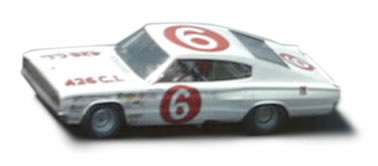
During the course of his career, Bobby Allison accumulated 84 victories, making him fourth all-time, tied with Darrell Waltrip, including three victories at the Daytona 500 in 1978, 1982 and 1988, where he finished one-two with his son, Davey Allison.
Allison campaigned the famous #6 Dodge for Cotton Owens in 1967, entering 9 races and winning 1 of them, at Birmingham, Alabama. He also had a couple of 2nd place finishes, including Richmond and Hampton, as well as several 3rd place finishes at Beltsville, Charlotte and Montgomery.
In 1972 he was voted national Driver of the Year for winning ten races and taking 11 poles (including a record 5 straight) and again in 1983 when he claimed his only championship. He was NASCAR Winston Cup Champion in 1983 driving for DiGard Racing. The 1982 Daytona 500 was fraught with controversy that became known as "Bumpergate". He also won the Firecracker 400 in 1982, making Allison the fourth driver to sweep both Cup point races at Daytona in the same year. Of note, after Allison accomplished this, no driver repeated such a feat until Jimmie Johnson did it in 2013. On May 23, 2011, Bobby Allison was inducted into the NASCAR Hall of Fame.
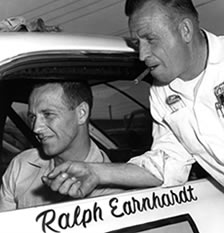 Ralph Earnhardt
Born: February 23, 1928
Ralph Earnhardt
Born: February 23, 1928
Died: September 26, 1973
Hometown: Kannapolis, NC
Driver for Cotton Owens Garage: 1961
Performance in COG cars:
Races: 7
Wins: 0
Top 5: 2
Top 10: 5
Poles: 0
View Ralph Earnhardt's induction into the International Motorsports Hall of Fame
View Ralph Earnhardt's career NASCAR driving statistics

Earnhardt began racing in 1949, and in 1953 it became his full-time occupation.
In 1956, he won the NASCAR Sportsman Championship, and was runner-up in 1955 and third in 1957. In 1967, he was the reigning South Carolina state champion, and track champion at Columbia Speedway and Greenville-Pickens Speedway.
He won the pole and finished second in his first Grand National race in 1956 at Hickory Speedway. In 1961, Ralph had his highest finish by finishing 17th in the Grand National point standings.
1961 also saw Ralph fill in as a relief driver for Cotton Owens in the Daytona 500, running more than 300 miles and finishing 5th.
Driving for Cotton Owens in the Rebel 300 at Darlington, South Carolina, Ralph Earnhardt, father of Dale Earnhardt Sr. and grandfather of Dale Earnhardt, Jr., makes his NASCAR Grand National debut on May 6, 1961. Earnhardt would compete in 7 races for Owens and earned 2 Top Five finishes and 5 Top Ten finishes, leading 90 laps while completing 1,602 laps.
 Sam McQuagg
Born: November 11, 1935
Sam McQuagg
Born: November 11, 1935
Died: January 3, 2009
Hometown: Columbus, GA
Driver for Cotton Owens Garage: 1967
Performance in COG cars:
Races: 6
Wins: 0
Top 5: 2
Top 10: 2
Poles: 0
View Sam McQuagg's Driver Profile page
View Sam McQuagg's career NASCAR driving statistics
View the wreck that prompted McQuagg to hang up his helmet

Born in Columbus, Georgia, McQuagg was named NASCAR Rookie of the Year in 1965 after achieving 5 top-10 finishes in 16 races. McQuagg was a major player in an incident in one of the wildest NASCAR races ever. McQuagg was leading the 1965 Southern 500, when Cale Yarborough tried to muscle past McQuagg for the lead. Yarborough flew over the guardrail, rolled around six times, and ended up at the end of the parking lot by a light post. Yarborough waved to the crowd as he walked back to the pits. A video clip of the wreck was used on ABC's Wide World of Sports for several years. The race was eventually won by 14 laps by Ned Jarrett.
Dodge noticed his accomplishments in his small Ford team, and Dodge hired him to their factory team. He was the first driver to use a spoiler. He used the spoiler to win the Firecracker 400 at Daytona International Speedway; the flag from the Firecracker 400 now hangs on his grandson's wall. His Dodge Charger was sponsored by a newlywed Georgia couple. McQuagg was also the first driver to bring a motorhome into the Daytona garage area.
In 1967 he was hired to drive Cotton Owens' Dodge. He ran 6 races, and had 2 top-5 finishes. On lap 81,
he tangled with another driver at Darlington, went over the guardrail, and flipped numerous times before coming to a rest. The wrecks frustrated McQuagg, and he scaled back his schedule to mainly local tracks. He retired from racing to become a commercial pilot, which was a skill he had learned to travel quickly between races. His last start came in World 600 in 1974.
 Junior Johnson
Junior Johnson
"The Last American Hero"
Born: June 28, 1931
Hometown: Wilkes County, NC
Driver for Cotton Owens Garage: 1962
Performance in COG cars:
Races: 4
Wins: 0
Top 5: 1
Top 10: 2
Poles: 0
View Junior Johnson's career NASCAR driving statistics
View Junior Johnson's career NASCAR owner statistics

Johnson was born in Wilkes County, North Carolina, the fourth of seven children of Lora Belle Money and Robert Glenn Johnson, Sr. His father, a lifelong bootlegger, spent nearly twenty of his sixty-three years in prison, as their house was frequently raided by revenue agents. Junior spent one year in prison in Ohio for having an illegal still, although he was never caught in his many years of transporting bootleg liquor at high speed.
In 1955, Johnson began his career as a NASCAR driver. In his first full season, he won five races and finished sixth in the 1955 NASCAR Grand National points standings.
In 1958 he won six races. In 1959, he won five more NASCAR Grand National races (including a win from the pole position at the 1959 Hickory 250); by this time he was regarded as one of the best short-track racers in the sport.
His first win at a "superspeedway" came at the Daytona 500 in 1960. Johnson and his crew chief Ray Fox were practicing for the race, trying to figure out how to increase their speed, which was 22 miles per hour slower than the top cars in the race. During a test run a faster car passed Johnson. He noticed that when he moved behind the faster car his own speed increased due to the faster car's slipstream. Johnson was then able to stay close behind the faster car until the final lap of the test run, when he used the "slipstream" effect to slingshot past the other car. By using this technique Johnson went on to win the 1960 Daytona 500, despite the fact that his car was slower than others in the field. Johnson's technique was quickly adopted by other drivers, and his practice of "drafting" has become a common tactic in NASCAR races.
In 1962, Cotton Owens surrendered his ride in the then Firecracker 250-miler at Daytona to Junior Johnson, who finished 2nd in the race.
In 1963 he had a two-lap lead in the World 600 at Charlotte before a spectator threw a bottle onto the track and caused Junior to crash; he suffered only minor injuries.
He retired in 1966. In his career, he claimed 50 victories as a driver, and 11 of these wins were at major speedway races. He retired as the winningest driver never to have a championship.
Johnson was inducted in the Motorsports Hall of Fame of America in 1991 and was named one of NASCAR's 50 Greatest Drivers in 1998. He was inducted into the NASCAR Hall of Fame on May 23, 2010.
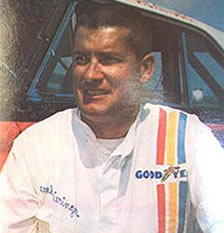 Darel Dieringer
Born: June 1, 1926
Darel Dieringer
Born: June 1, 1926
Died: October 28, 1989
Hometown: Indianapolis, IN
Driver for Cotton Owens Garage: 1967
Performance in COG cars:
Races: 3
Wins: 0
Top 5: 0
Top 10: 0
Poles: 0
View Darel Dieringer's career NASCAR driving statistics
Darel Dieringer made his debut in 1957 driving for John Zink and John Whitford but would see little success until 1963, when driving for Bill Stroppe, he won a race, logged 15 finishes in the top ten, and finished seventh in points. A solid 1964 was followed up by an even better 1965 season when Dieringer collected 15 more top tens in addition to another win and finished 3rd in series points behind Ned Jarrett and Dick Hutcherson while driving for Bud Moore and a variety of other owners. However, he struggled with reliability in 1966 and despite capturing three wins, including his biggest win of his career, the Southern 500, only finished 12th in points.
In 1967, Dieringer made 3 starts driving a Cotton Owens Dodge, including races at Charlotte, Rockingham, and Weaverville. Luck was not on his side as he qualified 6th at Rockingham and made his way to a 19th place finish before retiring after 257 out of 334 laps due to transmission failure. At Rockingham, he qualified 14th and went on to finish 22nd after completing 267 out of 500 laps until his day was ended with an engine issue. His last race for Owens at Weaverville resulted in a 30th place qualifying effort and a 23rd place finish, completing only 61 out of 500 laps before losing oil pressure and dropping out of the race.
Dieringer ran a part-time schedule in 1967 and 1968 with limited success and a single race in 1969. He was out of NASCAR until 1975 when he returned for the Charlotte and Superspeedway races. After those races, Dieringer would declare his ultimate retirement from motorsports forever.
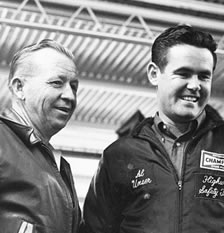 Al Unser
Born: May 29, 1939
Al Unser
Born: May 29, 1939
Hometown: Albuquerque, NM
Driver for Cotton Owens Garage: 1968
Performance in COG cars:
Races: 1
Wins: 0
Top 5: 1
Top 10: 1
Poles: 0
View Al Unser's career NASCAR driving statistics

Al Unser began racing in 1957, at age 18, initially competing primarily in modified roadsters, sprint cars and midgets. In 1965 he raced in the Indianapolis 500 for the first time and finished ninth.
He won the Indy 500 in 1970, two years after his brother, Bobby. During the race, he led for all but 10 of the 200 laps and averaged 155.749 miles per hour (250.654 km/h). His quick pit stops were a factor in the victory. That season he won a record 10 times on oval, road and dirt tracks to capture the United States Auto Club national championship. Unser competed in USAC's Stock Car division in 1967, and was the series Rookie of the Year.
In 1968, Unser came South to try his hand at stock car racing driving a Cotton Owens Dodge in the Daytona 500. He qualified 8th and finished a very respectable 4th.
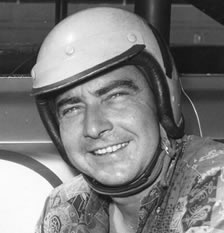 Fireball Roberts
Born: January 20, 1929
Fireball Roberts
Born: January 20, 1929
Died: July 2, 1964
Hometown: Tavares, FL
Driver for Cotton Owens Garage: 1961
Performance in COG cars:
Races: 1
Wins: 0
Top 5: 1
Top 10: 1
Poles: 0
View Fireball Roberts' career NASCAR driving statistics
He attended the University of Florida and raced on dirt tracks on weekends. In 1947, at the age of eighteen, he raced on the Daytona Beach Road Course at Daytona for the first time. He won a 150-mile race at Daytona Beach the following year. Roberts also competed in local stock and modified races at Florida tracks such as Seminole Speedway.
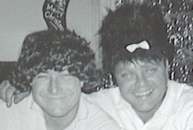
Roberts continued to amass victories on the circuit, despite the changes in NASCAR as it moved away from shorter dirt tracks to superspeedways in the 1950s and 1960s. In his 206 career NASCAR Grand National races, he won 33 times and had 32 poles. He finished in the top five 45 percent of the time.
In 1961, Fireball Roberts made his only start in a Cotton Owens Pontiac at Martinsville, starting in 8th position, leading 2 laps and finishing in 4th place. He won both the Daytona 500 and Firecracker 250 events in 1962 driving a black and gold 1962 Pontiac built by car builder legend Smokey Yunick.
On May 24, 1964, at the World 600 in Charlotte, Roberts had qualified in the eleventh position and started in the middle of the pack. On lap seven, Ned Jarrett and Junior Johnson collided and spun out and Roberts crashed trying to avoid them. Roberts' Ford slammed backward into the inside retaining wall, flipped over and burst into flames. Witnesses at the track claimed they heard Roberts screaming, "Ned, help me!", from inside his burning car after the wreck. Jarrett rushed to save Roberts as his car was engulfed by the flames. Roberts suffered second- and third-degree burns over eighty percent of his body and was airlifted to a hospital in critical condition. Although it was widely believed that Roberts had an allergic reaction to flame-retardant chemicals, he was secretly an asthmatic and the chemicals made his breathing worse.
Roberts was able to survive for several weeks, and it appeared he might pull through. But Roberts' health took a turn for the worse on June 30, 1964. He contracted pneumonia and sepsis and slipped into a coma by the next day. He died on July 2, 1964.
After Roberts' death, NASCAR mandated that all drivers must wear flame retardant coveralls while on track. They also instituted the five point safety harness, and the special, contoured drivers seat, all three of which are still requirements on all NASCAR entrants.
Despite having his career cut short and having never won a Grand National title, Fireball Roberts was named one of NASCAR's 50 Greatest Drivers. Other career awards he won include induction into the International Motorsports Hall of Fame in 1990, and the Motorsports Hall of Fame of America in 1995. In 2000, the city of Concord, North Carolina named a street near Charlotte Motor Speedway in his honor.
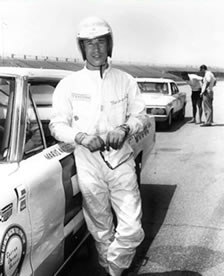 Mario Andretti
Born: February 28, 1940
Mario Andretti
Born: February 28, 1940
Hometown: Nazareth, PA
Driver for Cotton Owens Garage: 1966
Performance in COG cars:
Races: 1
Wins: 0
Top 5: 0
Top 10: 0
Poles: 0
View Mario Andretti's career NASCAR driving statistics
Mario Andretti is best known for his open wheel accomplishments, Andretti competed in fourteen NASCAR Grand National (Cup) events in his career. He competed in Holman Moody cars for his final ten events. Holman Moody was one of NASCAR's most successful teams at that time, as the team won NASCAR championships in 1968 and 1969 with driver David Pearson.
Andretti's only start for Cotton Owens came in 1966, when he qualified his #5 COG Dodge in 8th position for the Daytona 500. He finished in 31st place, with engine failure after completing 78 laps of 160. Andretti would go on to win the 1967 Daytona 500 driving for Holman Moody.
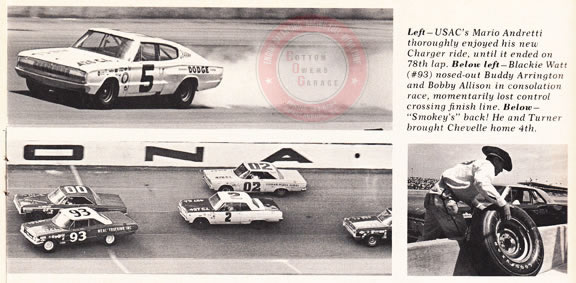
Andretti occasionally competed in United States Automobile Club (USAC) stock car events. He competed in USAC stock cars in 1965, and finished twelfth in the season points. He won a USAC Stock Car race in 1967, and finished seventh in the season points. He won three 1974 USAC stock car races on road courses, and won four road course races in 1975.
In 2000, the Associated Press and RACER magazine named him Driver of the Century. He was the Driver of the Year (in the United States) for three years (1967, 1978, and 1984), and is the only driver to be Driver of the Year in three decades. Andretti was named the U.S. Driver of the Quarter Century in 1992. He was inducted into the International Motorsports Hall of Fame in 2001, the United States National Sprint Car Hall of Fame in 1996, the Motorsports Hall of Fame of America in 1990, and the Hoosier Auto Racing Hall of Fame in 1970.
On October 23, 2006, Andretti was awarded the highest civilian honor given by the Italian government, the Commendatore dell'Ordine al Merito della Repubblica Italiana (known as the Commendatore), in honor of his racing career, public service, and enduring commitment to his Italian heritage. Enzo Ferrari is the only other recipient of the Commendatore from the world of automobile racing.
 Bobby Isaac
Born: August 1, 1932
Bobby Isaac
Born: August 1, 1932
Died: August 14, 1977
Hometown: Catawba, NC
Driver for Cotton Owens Garage: 1966
Performance in COG cars:
Races: 1
Wins: 0
Top 5: 0
Top 10: 0
Poles: 0
View Bobby Isaac's career NASCAR driving statistics
Bobby Isaac began racing full-time in 1956, but it took him seven years to break into the Grand National division. Isaac won the championship in 1970 driving the #71 Dodge Charger Daytona sponsored by K&K Insurance. His crew chief was legendary Harry Hyde. Isaac & Hyde took the car to Talladega in November and set a closed-course speed record.
Isaac made his only start driving a #5 Cotton Owens Dodge in 1966 at Rockingham, NC. He qualified in 26th position and finished 30th, retiring after 293 out of 500 laps due to a vibration.
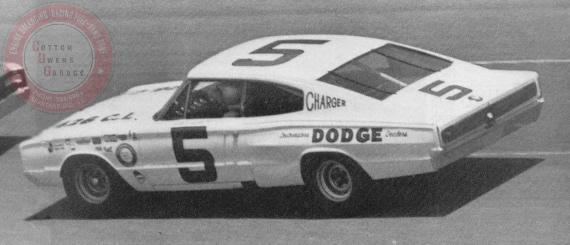
Isaac won 37 races in NASCAR's top series during his career, including 11 in his championship season, and started from the pole position 50 times. Isaac currently holds the NASCAR record for most poles in a single season,with 20 in 1969. In 1970 he turned a 201.104 mph lap at Talladega that stood until 1983. According to Isaac a strange "voice" in the car told him to retire from the Talladega race in 1973 because it threatened he would be killed. (Earlier in the race, another driver named Larry Smith died in an accident.)
Isaac also made his mark outside of NASCAR. In September 1971, he went to the Bonneville Salt Flats in Utah and set 28 world speed records, some of which still stand to this day.
Unfortunately, Bobby did not live to enjoy any of the accolades. He pulled out of a 1977 Late Model Sportsman race at Hickory Motor Speedway with 25 laps left, and called for a relief driver, collapsing on pit road. Though he was revived briefly at the hospital, a heart attack in the early morning hours proved fatal to the 45-year-old.
Bobby Isaac was inducted into the National Motorsports Press Association Hall of Fame in 1979, and the
International Motorsports Hall of Fame in 1996. In 1998 NASCAR honored Isaac as one of its NASCAR's 50 Greatest Drivers of all time.
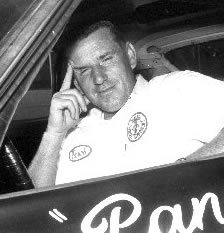 Marvin Panch
Born: May 28, 1926
Marvin Panch
Born: May 28, 1926
Hometown: Menomonie, WS
Driver for Cotton Owens Garage: 1961
Performance in COG cars:
Races: 1
Wins: 0
Top 5: 0
Top 10: 1
Poles: 0
View Marvin Panch's career NASCAR driving statistics
Marvin Panch started his racing career as a car owner in Oakland, California. One week, his driver did not show up, and he raced the car to a third place finish. He won a championship and several races in six years, including five NASCAR races on the West Coast of the United States.
He attempted his first East Coast race at Darlington Raceway in 1953. NASCAR founder Bill France, Sr. convinced him to come East for 1954. Lee Petty invited Panch to race in the 1954 Darlington race, where he finished third. The finish impressed Tom Horbison, who hired Panch to race his car during the 1955 season. His 1955 finishes impressed Pete DePaolo, who hired Panch to race in his factory Ford team. Panch won his first NASCAR race on July 20, 1956 at Montgomery Speedway after starting on the pole position and dominating the entire race.
He won the two races in 1957 for DePaolo. He added another victory in April before Ford ended its factory support in the middle of the season. Panch joined the legendary Holman-Moody team for the rest of the season. He won three more events in the season, and finished second in the final points standings.
The end of the Ford factory sponsorship hurt Panch's career. Over the next three seasons he was only able to race in 24 races.
He was offered a ride by legendary NASCAR mechanic Smokey Yunick in the 1961 Daytona 500. The car was a year old 1960 Pontiac. Panch took the offer, and won the 1961 Daytona 500 to put his career back on track.
Panch's turn behind the wheel of Owens' #6 Pontiac came at Atlanta in 1961, when he drove to a 10th place finish after qualifying in 11th position.
During the 1962 season he was offered a ride by legendary car owners the Wood Brothers. He accepted the ride in the Ford factory sponsored team. Panch had eight wins and 30 Top 3 finishes in 69 races for the team. He stayed with the team from 1962 to March 27, 1966, when Ford had another dispute with NASCAR. In 1965, A. J. Foyt finished the Atlanta 500 in Atlanta Motor Speedway in a car Panch started, taking it to victory. Panch received credit for the win.
Panch was hired by Lee Petty to race for Petty Enterprises for the 1966 World 600 in a year old car. Panch won the race for his final career victory, when Richard Petty was his relief driver. Panch raced for Petty Enterprises until he announced his retirement after the National 500 at Charlotte in October 1966.
Panch was named one of NASCAR's 50 Greatest Drivers in 1998. He inducted into the National Motorsports Press Association Hall of Fame in 1987, and the West Coast Stock Car Hall of Fame in its first class in 2002.
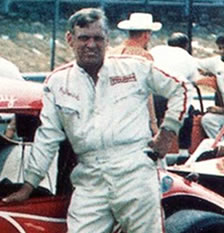 Ray Hendrick
Born: April 1, 1929
Ray Hendrick
Born: April 1, 1929
Died: September 28, 1990
Hometown: Richmond, VA
Driver for Cotton Owens Garage: 1967
Performance in COG cars:
Races: 1
Wins: 0
Top 5: 0
Top 10: 0
Poles: 0
View Ray Hendrick's career NASCAR driving statistics
Ray Hendrick was known as "Mr. Modified" during his 36-year career in motorsports mainly in the modified stock car racing class.
The Virginia native collected more than 700 victories in modifieds, NASCAR Winston Cup series, and late model sportsman series (later known as Busch Grand National division). Ray Hendrick was the first inductee into the Virginia Hall of Fame and was inducted in the International Motorsports Hall of Fame in 2007.
Hendrick raced his famous winged No. 11 Modified coupe fielded by Jack Tant and Clayton Mitchell. Rick Hendrick (no relation) was a pit crew member on his car in the 1960s. The Richmond, Virginia star won five track championships at South Boston Speedway, four of them while competing in the NASCAR Modified division and one in the NASCAR Late Model Sportsman division.
Ray's driving talents earned him a start behind the wheel of Cotton Owens' Dodge in 1967, when he drove to a 21st place finish after qualifying in 15th position. Engine trouble shortened his day and he was forced to the pits after completing 107 of 300 laps.
Hendrick was best known for his racing philosophy of racing anywhere and everywhere. Hendrick's modified career and philosophy of racing anywhere and everywhere prevented him from competing full time in NASCAR Winston Cup. In 17 starts, he collected two top-five and six top-10 finishes.
Other notable drivers who have climbed behind the wheel of a Cotton Owens Garage racecar include Earl Balmer, Dick Brooks, Joe Eubanks, A.J. Foyt, Peter Gregg, Charlie Griffin, James Hylton, Bobby Johns, Roger McClusky, Jim Paschal, Richard Petty, Sam Posey, Dick Rathman, and Larry Thomas. Test drivers included Lynn Sutton, Roger Ward and Jim Wright.












 Glotzbach piloted his Cotton Owens Dodge to victory at the 1968 National 500 at Charlotte. They also lost the Daytona 500 of 1969 by a mere .01 of a second to Ford-Mercury king LeeRoy Yarborough. After the Atlanta 500-miler in March, 1969, Glotzbach became fed up with NASCAR rules and quit, which opened the door for Buddy Baker to join up with Owens.
Glotzbach piloted his Cotton Owens Dodge to victory at the 1968 National 500 at Charlotte. They also lost the Daytona 500 of 1969 by a mere .01 of a second to Ford-Mercury king LeeRoy Yarborough. After the Atlanta 500-miler in March, 1969, Glotzbach became fed up with NASCAR rules and quit, which opened the door for Buddy Baker to join up with Owens.



















